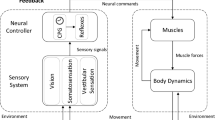Abstract
The aim of this study was to investigate the effect of single joint displacement on the pattern of leg muscle electromyographic (EMG) activity during locomotion. For the first time, unilateral rotational hip or knee joint displacements were applied by a driven orthotic device at three phases of swing during locomotion on a treadmill. The response pattern of bilateral leg muscle activation with respect to the timing and selection of muscles was almost identical for displacements of upper (hip joint) or lower (knee joint) leg. The leg muscle EMG responses were much stronger when the displacement was directed against the physiological movement trajectory, compared with when the displacement was reinforcing, especially during mid swing. It is suggested that these response patterns are designed to restore physiological movement trajectory rather than to correct a single joint position. Displacements released at initial or terminal swing, assisting or resisting the physiological movement trajectory, were followed by similar and rather unspecific response patterns. This was interpreted as being directed to stabilise body equilibrium.






Similar content being viewed by others
References
Andersson O, Grillner S (1983) Peripheral control of the cat’s step cycle. II. Entrainment of the central pattern generators for locomotion by sinusoidal hip movements during “fictive locomotion”. Acta Physiol Scand 118:229–239
Colombo G, Joerg M, Schreier R, Dietz V (2000) Treadmill training of paraplegic patients using a robotic orthosis. J Rehabil Res Dev 37:693–700
Dietz V (1992) Human neuronal control of automatic functional movements. Interaction between central programs and afferent input. Physiol Rev 72:33–69
Dietz V (2002) Do human bipeds use quadrupedal coordination? TINS 25:462–467
Dietz V, Quintern J, Berger W (1986a) Stumbling reactions in man: Release of a ballistic movement pattern. Brain Res 362:355–357
Dietz V, Quintern J, Boos G, Berger W (1986b) Obstruction of the swing phase during gait: phase-dependent bilateral leg muscle coordination. Brain Res 384:166–169
Dietz V, Quintern J, Sillem M (1987) Stumbling reactions in man—significance of proprioceptive and pre-programmed mechanisms. J Physiol 386:149–163
Dietz V, Horstmann G, Berger W (1989) Interlimb co-ordination of leg muscle activation during perturbation of stance in humans. J Neurophysiol 62:680–693
Ghori GMU, Luckwill RG (1989) Pattern of reflex responses in lower-limb muscles to a resistance in walking man. Eur J Appl Physiol 58:852–857
Gollhofer A, Schmidtbleicher D, Quintern J, Dietz V (1986) Compensatory movements following gait perturbations: changes in kinematic and muscular activation patterns. Int J Sports Med 7:325–329
Gorassini MA, Prochazka A, Hiebert GW, Gauthier MJA (1994) Corrective responses to loss of ground support during walking. I. Intact cats. J Neurophysiol 71:603–610
Grillner S, Rossignol S (1978) On the initiation of the swing phase of locomotion in chronic spinal cats. Brain Res 146:269–277
Hiebert GW, Gorassini MA, Jiang A, Prochazka A, Pearson KG (1994) Corrective responses to loss of ground support during walking. II. Comparison of intact and chronic spinal cats. J Neurophysiol 71:611–622
Hiebert GW, Whelan PJ, Prochazka A, Pearson KG (1996) Contribution of hind limb flexor muscle afferents to the timing of phase transitions in the cat step cycle. J Neurophysiol 75:1126–1137
Kriellaars DJ, Brownstone RM, Noga BR, Jordan LM (1994) Mechanical entrainment of fictive locomotion in the decerebrate cat. J Neurophysiol 71:2074–2086
Misiaszek JE, Stephens MJ, Yang JF, Pearson KG (2000) Early corrective reactions of the leg to perturbations at the torso during walking in humans. Exp Brain Res 131:511–523
Okamoto T, Goto Y (1985) Human infant pre-independent and independent walking. In: Kondo S (ed) Primate morphophysiology, locomotor analysis and human bipedalism. University of Tokyo Press, Tokyo
Pang MYC, Yang JF (2000) The initiation of the swing phase in human infant stepping: Importance of hip position and leg loading. J Physiol 528:389–404
Pang MYC, Yang JF (2001) Interlimb co-ordination in human infant stepping. J Physiol 533:617–625
Prokop T, Berger W, Zijlstra W, Dietz V (1995) Adaptational and learning processes during split-belt locomotion: interaction between central mechanisms and afferent input. Exp Brain Res 106:449–456
Schomburg ED, Peteresen N, Barajon I, Hultborn H (1998) Flexor reflex afferents reset the step cycle during fictive locomotion in the cat. Exp Brain Res 122:339–350
Sinkjaer T, Andersen JB, Larsen B (1996) Soleus stretch reflex modulation during gait in humans. J Neurophysiol 76:1112–1120
Yang JF, Stephens MJ, Vishram R (1998) Transient disturbances to one limb produce coordinated, bilateral responses during infant stepping. J Neurophysiol 79:2329–2337
Acknowledgements
This work was supported by the Swiss National Science Foundation (No 31-53526.98 and No. 3152-062025) and the NCCR on Neural Plasticity and Repair.
Author information
Authors and Affiliations
Corresponding author
Rights and permissions
About this article
Cite this article
Dietz, V., Colombo, G. & Müller, R. Single joint perturbation during gait: neuronal control of movement trajectory. Exp Brain Res 158, 308–316 (2004). https://doi.org/10.1007/s00221-004-1904-3
Received:
Accepted:
Published:
Issue Date:
DOI: https://doi.org/10.1007/s00221-004-1904-3




